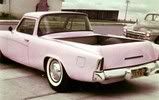Ok fellow Studenuts,
Here is my problem with my 57 Champion flathead with 27,000 original miles. Some of you have guided me in the past and I value your opinions. Some of you who know me from eons ago know that I have been a purist. All attempts to solve my knocking problem have proved to no avail. A friend at school has given me, yes-given me a crate 4 bolt main GMC 350 with four speed tranny.
I have anguished over this choice and given current monetary situations the most cost effective method is to change engines. I would keep this engine and restore at a later date. This would give me the horsepower to make SDC meets and keep up with traffic and not worry.
Any advice in pointing me in the right direction will be greatly appreciated. I can also hear Gary and Tom P. in NY both gasping.
Thanks, everyone!!!
1957 Studebaker Champion 2 door. Staten Island, New York.
Here is my problem with my 57 Champion flathead with 27,000 original miles. Some of you have guided me in the past and I value your opinions. Some of you who know me from eons ago know that I have been a purist. All attempts to solve my knocking problem have proved to no avail. A friend at school has given me, yes-given me a crate 4 bolt main GMC 350 with four speed tranny.
I have anguished over this choice and given current monetary situations the most cost effective method is to change engines. I would keep this engine and restore at a later date. This would give me the horsepower to make SDC meets and keep up with traffic and not worry.
Any advice in pointing me in the right direction will be greatly appreciated. I can also hear Gary and Tom P. in NY both gasping.
Thanks, everyone!!!
1957 Studebaker Champion 2 door. Staten Island, New York.





Comment